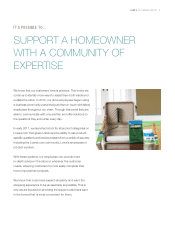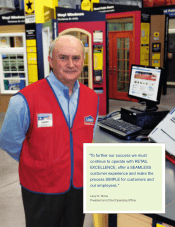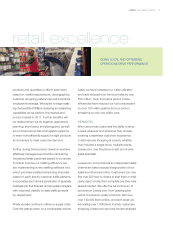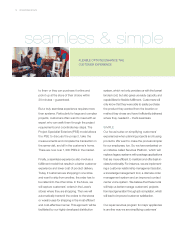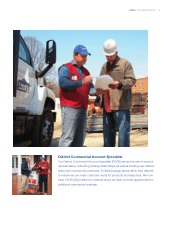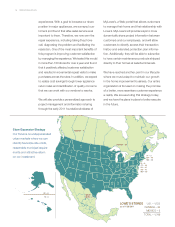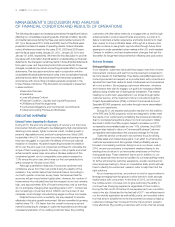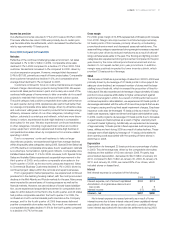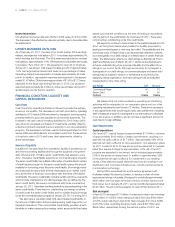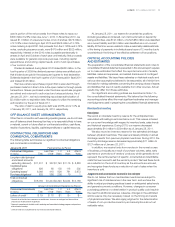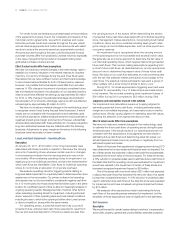Lowe's 2010 Annual Report Download - page 22
Download and view the complete annual report
Please find page 22 of the 2010 Lowe's annual report below. You can navigate through the pages in the report by either clicking on the pages listed below, or by using the keyword search tool below to find specific information within the annual report.18 LOWE’S 2010 ANNUAL REPORT
The following discussion and analysis summarizes the significant factors
affecting our consolidated operating results, financial condition, liquidity
and capital resources during the three-year period ended January 28,
2011 (our fiscal years 2010, 2009 and 2008). Each of the fiscal years
presented contains 52 weeks of operating results. Unless otherwise
noted, all references herein for the years 2010, 2009 and 2008 repre-
sent the fiscal years ended January 28, 2011, January 29, 2010 and
January 30, 2009, respectively. We intend for this discussion to provide
the reader with information that will assist in understanding our financial
statements, the changes in certain key items in those financial statements
from year to year, and the primary factors that accounted for those
changes, as well as how certain accounting principles affect our financial
statements. This discussion should be read in conjunction with the
consolidated financial statements and notes to the consolidated financial
statements included in this annual report that have been prepared in
accordance with accounting principles generally accepted in the
United States of America. This discussion and analysis is presented
in seven sections:
•ExecutiveOverview
•Operations
•Lowe’sBusinessOutlook
•FinancialCondition,LiquidityandCapitalResources
•Off-BalanceSheetArrangements
•ContractualObligationsandCommercialCommitments
•CriticalAccountingPoliciesandEstimates
EXECUTIVE OVERVIEW
External Factors Impacting Our Business
During 2010, the economy showed signs of recovery, but the home
improvement industry continued to be challenged by high unemployment,
declining home values, tighter consumer credit, modest growth in
personal disposable income, and low housing turnover. Since 2008,
households in the U.S. have been borrowing less and saving more as
they have struggled to cope with the effects of the worst national
recession in decades. Household spending increased modestly in
2010 over the prior year, but consumers continued to rationalize the
scope of their housing projects, focusing on mini projects and small
enhancements versus major renovations. We saw evidence of this
constrained growth, as our comparable store sales increased by
1.3% versus the prior year, which was our first comparable store
sales increase for the year since 2005.
Although quantitative measures of consumer sentiment and
confidence are up from their low points during the depths of the
recession, they remain below their historical means. According to
our fourth quarter consumer survey, fewer homeowners feel the
economy will get worse before it gets better. However, the number of
homeowners who indicated they feel the recession is not over remains
high,andapproximately45%ofthosehomeownerstoldusthatthey
do not anticipate changing their spending plans in 2011. Consumers
are increasingly concerned about inflation as the prices of raw
materials, oil and foreign manufacturing wages continue to increase.
Despite the economic uncertainty, we are prepared to operate
effectively in this slow growth environment. We are committed to growing
market share 1% – 2% faster than the overall home improvement
marketbyadaptingtochangesincustomerexpectationsandthrough
increasedpenetrationofourexistingcustomerbase.Byproviding
customers with alternative methods to engage with us and through
enhancements in product assortments and pricing, our plan is to
delivercustomersabetterexperienceandbettersolutionstomeet
their needs to drive profitable sales. Although at a slower pace,
we also continue to see growth opportunities through future store
expansioninunder-penetratedurbanmarketsintheU.S.andinwestern
Canada. In addition, we have implemented changes that set the
foundation for longer-term improvements in efficiency and cost control.
Business Strategies
Driving profitable sales
Inourresearch,customershavesaidtheyexpectmorefromahome
improvement company and want home improvement companies to
be more relevant to their lifestyles. They desire a simplified approach to
homeimprovementandexpectustoprovidethemwithproductsand
services that meet their desire for ease, intuitiveness and convenience
all in one solution. By engaging customers whenever, wherever
and however they wish to engage, our goal is to increase profitable
sales by doing a better job of closing every transaction. This means
meetingourcustomers’expectationsinourstoresthroughbetter
customer service, at the customer’s home or job site through the
ProjectSpecialistExterior(PSE)orDistrictCommercialAccount
Specialist (DCAS) programs, and online through a more personalized
Lowes.comexperience.
During2010,weexperiencedpositiveresultsfromtheaddition
of the PSE and DCAS programs, which are designed to better meet
the needs of our customers by simplifying the process and allowing
them to complete transactions where it is most convenient. Initially
launched in 2009, the PSE program helped to increase our 2010
comparable store installed sales by over 10%. Likewise, the DCAS
program also helped to drive our Commercial Business Customer
comparable store sales above the company average for the year.
Customer service continues to be a primary focus for driving
profitable sales and market share gains. In an effort to enhance the
customerexperienceanddrivegreaterticketprotabilityweare
focused on increasing customer-facing hours in our stores. Late in
2010, we announced plans to implement weekend teams to the
existingstorestructuretoputmoresalesemployeesontheoor
during peak days. These weekend teams are in addition to our
normal seasonal hires and are an addition to our base staffing model.
Tofurtherenhancethecustomerexperience,wealsorevampedour
store employee training to focus on consultative skills, which will help
them to identify the customers’ needs in order to help them find the
right solutions.
As our business evolves, we continue to look for opportunities to
leverage emerging technologies and online trends to build stronger
relationships with consumers. At the end of 2010, we introduced
the mobile version of Lowes.com to give customers the ability to
continuetheirshoppingexperienceregardlessoftheirlocation.
Duringtherstmonthofthelaunchweexperiencedoveronemillion
visits to the site. Scheduled for the first half of 2011, we will also launch
our first mobile application as well as MyLowe’s, an innovative online
tool that aims to simplify the home improvement process by helping
customers manage their homes and home improvement projects
more effectively. By providing customers with cross-channel access
MANAGEMENT’S DISCUSSION AND ANALYSIS
OF FINANCIAL CONDITION AND RESULTS OF OPERATIONS



